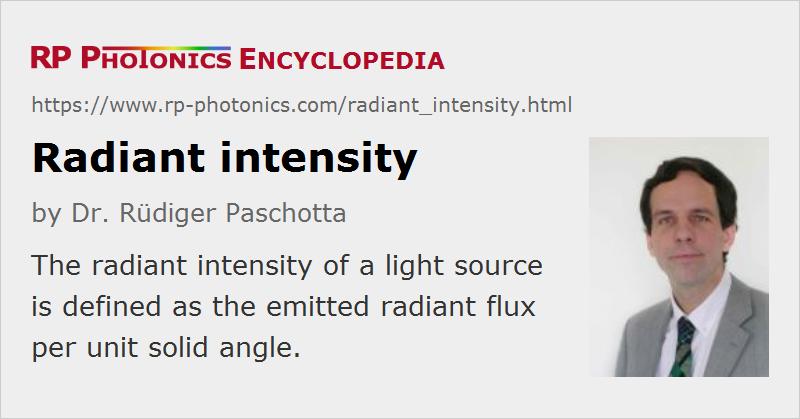Radiant Intensity
Definition: radiant flux per unit solid angle
German: Strahlstärke
Categories: general optics, light detection and characterization, optical metrology
Formula symbol: Ie,Ω or I
Units: W/sr
How to cite the article; suggest additional literature
Author: Dr. Rüdiger Paschotta

The radiant intensity Ie,Ω (or just I) of a light source is defined as the emitted radiant flux per unit solid angle. It can also be applied to transmitted, reflected or received radiation. The term is mostly applied with the approximation of a point source, i.e., in distances which are large to the extent of the source.
In the SI system, radiant intensities are specified in units of W/sr (watts per steradian). The corresponding photometric quantity is the luminous intensity in units of candela (cd) = lm/sr.
At a distance d from a source with radiant intensity I, an area element with its normal direction at an angle θ against the direction to the source receives an irradiance E = I cos θ / d2. The total radiant flux of a source with uniform omnidirectional emission (i.e., and intensity not depending on the direction) is Φ = 4 π I.
A related radiometric quantity is the spectral intensity, which is defined as the radiant intensity per unit optical frequency or wavelength interval.
Generally, the radiant intensity depends on the observation direction, and the total radiant flux is obtained by integration over all directions. In case of isotropic radiation (i.e., with constant radiant intensity), the total radiant flux is simply 4π sr times the radiant intensity.
The radiant intensity is relevant, for example, for calculating how much optical intensity impinges a photodetector placed in some distance from the light source.
In contrast to the radiance, the emitting area does not matter for the radiant intensity. The radiance can be considered as radiant intensity per unit emitting area.
The radiant intensity should not be confused with the optical intensity as used in optical physics.
Questions and Comments from Users
Here you can submit questions and comments. As far as they get accepted by the author, they will appear above this paragraph together with the author’s answer. The author will decide on acceptance based on certain criteria. Essentially, the issue must be of sufficiently broad interest.
Please do not enter personal data here; we would otherwise delete it soon. (See also our privacy declaration.) If you wish to receive personal feedback or consultancy from the author, please contact him e.g. via e-mail.
By submitting the information, you give your consent to the potential publication of your inputs on our website according to our rules. (If you later retract your consent, we will delete those inputs.) As your inputs are first reviewed by the author, they may be published with some delay.
See also: radiometry, radiant flux, radiance, irradiance
and other articles in the categories general optics, light detection and characterization, optical metrology
 |




If you like this page, please share the link with your friends and colleagues, e.g. via social media:
These sharing buttons are implemented in a privacy-friendly way!